Safety Warning Letter
[Your Name]
[Your Address]
[City, State, Zip Code]
[Email Address]
[Phone Number]
[Today's Date]
[Recipient's Name]
[Recipient's Position/Title]
[Company/Organization Name]
[Address]
[City, State, Zip Code]
Subject: Safety Warning Letter
Dear [Recipient's Name],
I hope this letter finds you well. I am writing to bring to your attention a matter of great importance regarding safety concerns that have come to my attention. As an advocate for the well-being and security of all individuals involved in our operations, I feel compelled to address this issue promptly.
The purpose of this letter is to formally warn you and the entire team about certain safety violations that have been observed within the organization. It is essential to recognize that the failure to comply with safety guidelines not only puts our employees and stakeholders at risk but also exposes the company to potential legal and financial repercussions.
The specific safety violations that have been identified are as follows:
1. Failure to wear appropriate personal protective equipment (PPE) in designated areas.
2. Inadequate training and lack of awareness regarding safety protocols for handling hazardous materials.
3. Ignoring or bypassing safety procedures during equipment operation.
4. Poor housekeeping practices, leading to potential slip and trip hazards.
5. Insufficient emergency response preparedness and drills.
I strongly urge you and your team to take immediate action to rectify these safety concerns. It is imperative that safety protocols and guidelines are thoroughly reviewed, communicated, and enforced to ensure the well-being of all employees and stakeholders.
To address these issues effectively, I propose the following steps:
1. Conduct a comprehensive safety training program for all employees to reinforce safety protocols and emphasize the importance of compliance.
2. Implement regular safety inspections and audits to identify potential hazards and ensure ongoing adherence to safety standards.
3. Appoint a designated safety officer responsible for monitoring, reporting, and resolving safety-related issues.
4. Develop and distribute safety guidelines and manuals to every employee, ensuring everyone is well-informed about safety procedures.
5. Organize regular emergency response drills to ensure everyone knows how to respond effectively in critical situations.
Please acknowledge your receipt of this warning letter and provide a written response detailing the actions you and your team will take to address and prevent these safety violations. The response must be submitted no later than [deadline date, usually within 10-14 days].
Please understand that failure to address and rectify these safety concerns promptly may result in further disciplinary actions, up to and including termination of employment for those found to be in repeated violation of safety regulations.
I trust that you will treat this matter with the utmost seriousness and urgency it deserves. Our commitment to maintaining a safe work environment is non-negotiable, and I am confident that with collective efforts, we can achieve a safer and more secure workplace for everyone.
If you have any questions or require additional support in addressing these safety concerns, please do not hesitate to reach out to me.
Thank you for your immediate attention to this matter.
Sincerely,
[Your Name]
[Your Position/Title]
[Company/Organization Name]
Formal Safety Warning Letter for Workplace Incident
Dear [Employee Name],
This letter serves as a formal warning regarding the unsafe conduct observed on [Date] during [specific task or situation]. Your actions violated company safety protocols, specifically [mention regulation or guideline].
Continued disregard for safety procedures may result in disciplinary action, including suspension or termination. We expect immediate compliance with all safety measures and recommend reviewing the company safety manual thoroughly.
Sincerely,
[Manager/Supervisor Name]
[Position]
Provisional Safety Warning Letter for Investigation
Dear [Employee Name],
We are issuing this provisional warning due to a reported safety concern involving your activities on [Date]. This notice does not conclude our investigation but serves to alert you to the potential hazard.
Please provide any relevant information during the upcoming review meeting. Compliance with safety policies is mandatory while the investigation is ongoing.
Sincerely,
[Safety Officer/HR Representative]
Casual Safety Reminder Email
Hi [Employee Name],
I wanted to remind you about the importance of following safety protocols, especially regarding [specific procedure or equipment]. Ensuring everyone's safety is critical, and minor oversights can cause serious incidents.
Please take a moment to review the guidelines and stay vigilant.
Thanks,
[Supervisor Name]
Heartfelt Safety Concern Letter
Dear [Employee Name],
It is with concern that we must address an unsafe incident that occurred on [Date]. While we value your contributions, the observed behavior placed yourself and colleagues at risk.
We ask you to take immediate corrective action and attend the upcoming safety training. Your well-being is important to us, and adhering to safety measures is essential for a secure work environment.
Warm regards,
[Manager Name]
Quick Safety Alert Message
Hello [Employee Name],
This is a quick safety alert regarding unsafe practices observed today in [area or task]. Please review the safety protocols immediately to prevent potential accidents.
Thank you for your attention.
Best,
[Safety Team]
Formal Safety Warning for Repeated Offense
Dear [Employee Name],
This is a formal warning following repeated violations of safety protocols despite previous counseling on [Dates]. Such repeated actions are unacceptable and pose serious risks to yourself and others.
Failure to improve may lead to further disciplinary action. We urge you to strictly adhere to all safety procedures moving forward.
Sincerely,
[HR/Safety Officer Name]
Creative Safety Awareness Letter
Dear Team,
Safety is everyone’s responsibility, and today we observed several risky behaviors that could lead to accidents. Please treat this letter as a friendly yet firm reminder to follow all safety protocols.
Remember, a safe workplace protects you and your colleagues. Let's stay alert and proactive in preventing hazards.
Best regards,
[Safety Manager]
What / Why: Purpose of a Safety Warning Letter
- A safety warning letter is issued to formally alert employees about unsafe behavior or potential hazards in the workplace.
- Its purpose is to prevent accidents, ensure compliance with regulations, and maintain a safe environment.
- It serves as a documented record for both employee awareness and organizational accountability.
Who Should Send a Safety Warning Letter
- Immediate supervisors or team leads witnessing the unsafe conduct.
- HR representatives for formal documentation.
- Safety officers or compliance managers responsible for enforcing workplace safety.
- Management in cases of repeated or serious violations.
Whom the Letter Should Be Addressed To
- Individual employees involved in unsafe activities.
- Teams or groups if the hazard affects multiple people.
- Contractors or temporary staff when observed non-compliance.
- Occasionally, union representatives if required by policy.
When to Send a Safety Warning Letter
- After a documented safety violation or incident.
- When repeated unsafe behavior is observed despite prior counseling.
- Following near-miss events to prevent future accidents.
- During routine safety audits if non-compliance is noted.
How to Write and Send a Safety Warning Letter
- Clearly describe the observed unsafe behavior with date, time, and location.
- Reference specific safety policies or regulations that were violated.
- Suggest corrective measures or mandatory training.
- Maintain a professional and serious tone for formal letters.
- Choose the delivery method: email for quick alerts, printed letter for official records.
Formatting Guidelines for Safety Warning Letters
- Length: 1–2 pages, concise but detailed.
- Tone: Professional, serious, empathetic for first-time infractions; firm for repeated offenses.
- Wording: Clear, factual, and non-accusatory.
- Structure: Introduction (reason), body (details and consequences), conclusion (actions required), signature.
- Attachments: Photos, incident reports, or relevant safety documentation.
Requirements and Prerequisites Before Sending
- Gather evidence of unsafe behavior (photos, reports, witness statements).
- Verify company safety policies and relevant legal obligations.
- Document any prior warnings or counseling sessions.
- Identify the corrective actions or training needed.
After Sending / Follow-up
- Schedule a meeting to discuss the warning and ensure understanding.
- Monitor employee compliance with safety protocols.
- Document follow-up actions and improvements.
- Escalate to disciplinary measures if behavior continues.
Pros and Cons of Sending a Safety Warning Letter
Pros:
- Raises awareness and reduces risk of accidents.
- Provides documented evidence for compliance and HR records.
- Encourages a culture of safety in the workplace.
Cons:
- May create tension between management and staff.
- Risk of misinterpretation if tone is too harsh or unclear.
- Requires careful documentation and follow-up.
Tricks and Tips for Effective Safety Warning Letters
- Be specific: describe behavior, time, and location.
- Reference company policies or legal safety standards.
- Offer support like training sessions or safety resources.
- Maintain balance between firmness and empathy.
- Use bullet points for clarity on actions required.
Common Mistakes to Avoid in Safety Warning Letters
- Vague descriptions of the unsafe act.
- Using accusatory or emotional language.
- Failing to provide corrective guidance.
- Sending letters without proper documentation or witness accounts.
Elements and Structure of a Safety Warning Letter
- Introduction: Purpose of the letter and summary of incident.
- Details: Date, time, location, and nature of safety violation.
- Policy Reference: Cite relevant safety regulations.
- Corrective Measures: Required actions, training, or changes.
- Consequences: Potential disciplinary measures for repeated violations.
- Closing: Contact for further discussion or clarification.
- Attachments: Incident reports, photos, or supporting documents.
FAQ About Safety Warning Letters
-
Q: Can a safety warning be issued verbally instead of in writing?
A: Yes, but written warnings provide formal documentation and legal compliance. -
Q: Is a warning required for minor infractions?
A: It depends on company policy; minor infractions may be addressed with reminders or training. -
Q: Can a safety warning letter affect employment status?
A: Repeated or severe violations can lead to disciplinary action, including termination.
Compare and Contrast With Other Safety Communications
- Safety Warning vs Safety Reminder: Warnings are formal and documented; reminders are informal and proactive.
- Safety Warning vs Incident Report: Warnings address individual behavior; reports document the event for record-keeping.
- Safety Warning vs Verbal Counseling: Written warnings provide proof of notification; verbal counseling may not be sufficient for repeated issues.
Does It Require Attestation or Authorization?
- Safety warning letters typically require approval from HR or a supervisor.
- Signature or acknowledgment from the employee ensures receipt and understanding.
- Documentation may be necessary for regulatory compliance or legal purposes.

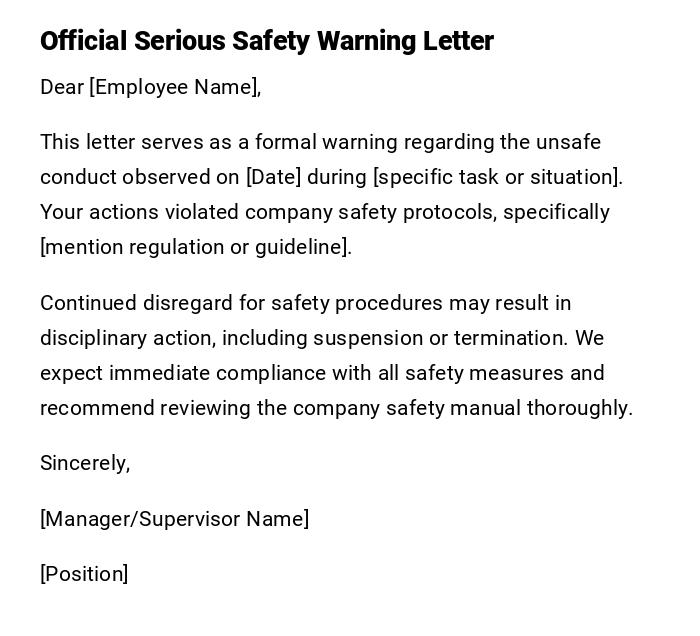
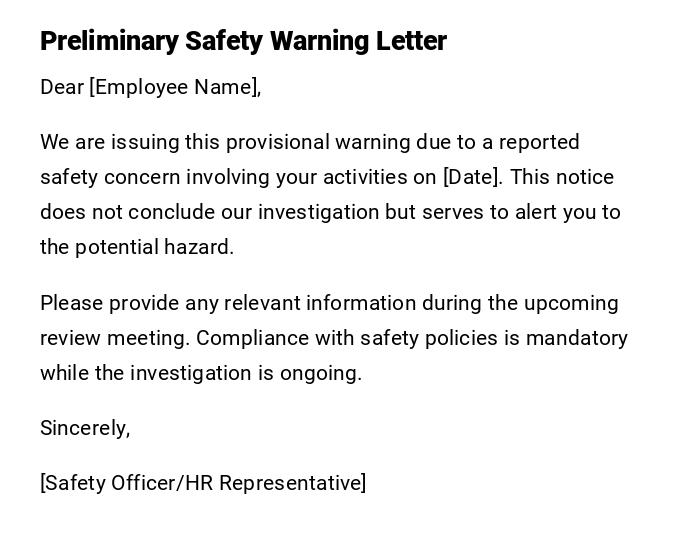
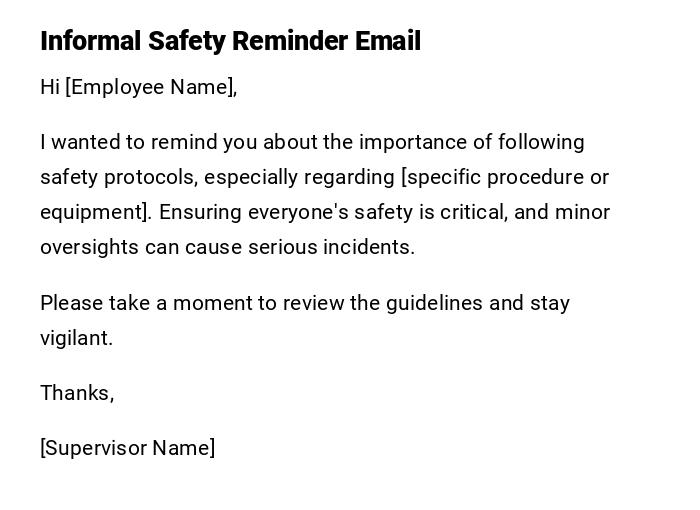
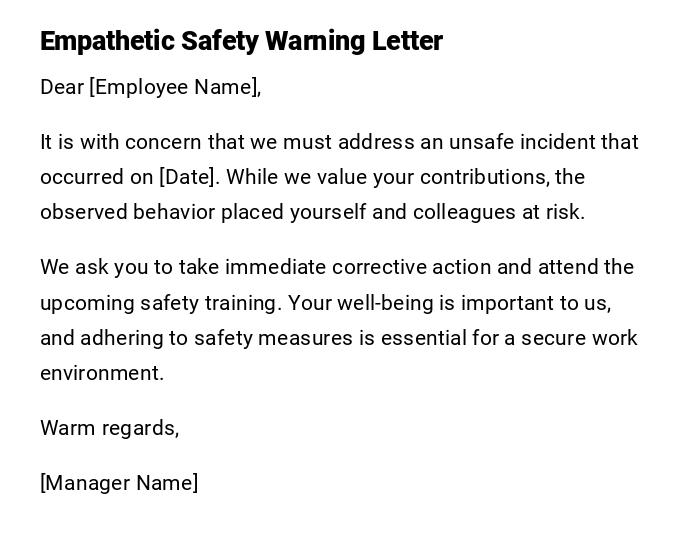
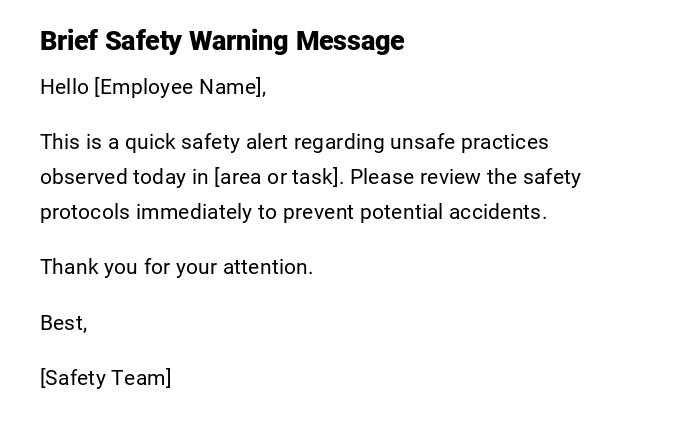
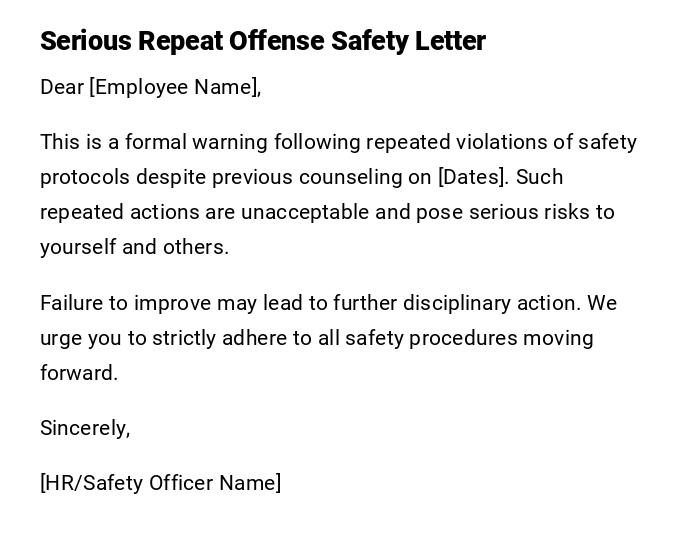
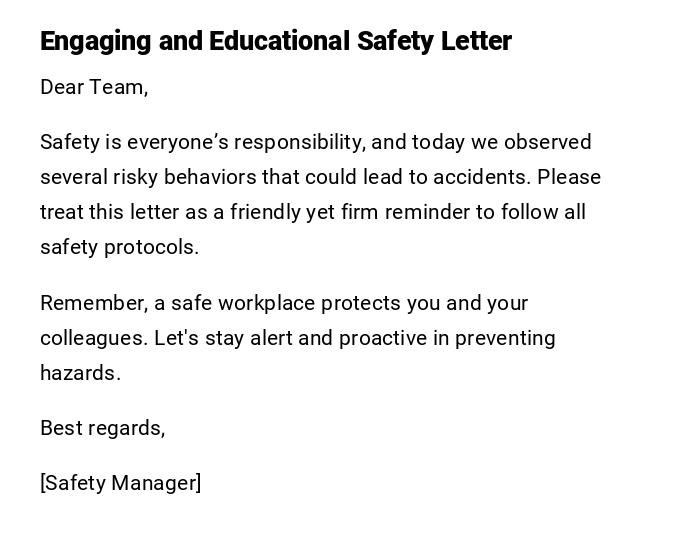

 Download Word Doc
Download Word Doc
 Download PDF
Download PDF